|
Welcome to Healing Yoga for Cancer Survivorship, a gentle yoga program specifically designed to build breath and body awareness, increase energy, circulation and lymphatic drainage, reduce anxiety, fatigue, sleeplessness, constipation and pain for those going through cancer treatment. The sequence provides instruction on intention setting that is done at the beginning of the session; simple sound practices to focus your attention and bring you more closely into contact with your center; mudra or hand gestures to calm the mind and emotions; breathing techniques to increase prana, the vital force in your body that is helpful for healing; and a progression of yoga postures from a reclining position to sitting to kneeling to standing that will move all the joints in the body; we will finish with restorative yoga and meditation techniques that will refresh the body, mind and spirit. Feel free to practice the entire sequence or only the sections that feel appropriate for you on any particular day. Try to practice for a few minutes each day to give your body and mind the time and space to heal. It is best to practice with a yoga mat on a hard floor surface. The yoga mat provides both cushion and traction for your feet during the standing postures. You may also need a folded blanket for some of the postures, especially for the head during the reclining postures and to sit on to make sitting on the floor more comfortable. Fold the blanket so that you sit on the long folded edge and sit high enough so that the knees fall at or below the hip bones. If sitting on the floor is not comfortable, please feel free to sit in a chair instead. PLEASE BE CAUTIOUS: Be sure to stay mindful of the body and breath throughout the practice, and only do the movements in a range of motion that is completely comfortable and in a way that your breath stays normal and fluid. If a movement or practice causes discomfort, pain, dizziness, nausea or breathlessness, please stop immediately and rest for a few moments. Listen to the cues and messages from your body before deciding if it would be appropriate to move on to a more gentle technique or if you need to stop practicing for today. 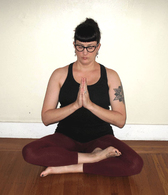 SETTING YOUR INTENTION We will begin with an intention setting meditation which guides you through setting a sankalpa (an intention or resolve) for your practice. Once you create your intention, continue to use it before your practice each day. You will repeat the sankalpa three times silently at the beginning of your practice and then call it to mind again at the end of your practice. This repetition plants a seed for self-transformation deep within your mind to assist you on your path towards healing. At some point in the future, you may feel the need to change the sankalpa if it has come to fruition or you are not resonating with it any longer. Then it would be appropriate for you to go through this meditation again. Begin sitting in a comfortable seated position with the palms resting together at the heart. Feel the breath gently directed into the chest which will encourage your deepest wish for self-transformation to arise. Bring to mind the current challenges that you are facing. Without dwelling on the details, recognize that all challenges are opportunities for personal growth and healing. Perhaps your current challenges have already set the stage for transformation in your life. Continue to visualize this challenging situation and hold it within the space of the heart, releasing any feelings of judgment or blame if they arise. Begin to visualize the best possible outcome for the challenges you are facing. If any thoughts of doubt begin to arise, redirect the mind towards receptivity and the positive resolution of your current situation. Whatever steps need to be taken, imagine taking them with self-confidence bringing this outcome into reality. Trust that you have the strength, courage and ability to bring the imagined positive outcome into reality. Be confident that you can create your own reality based on your visualization. Allow your intention to coalesce into a short simple statement phrased in the present tense beginning with the words "I am ...". State it silently three times. Trust that your sankalpa will manifest with patience and repetition and repeat it mentally before each yoga practice.. Take a few more breaths to firmly implant this heartfelt wish into your consciousness. CHANTING Creating sound is a wonderful way to center the body and mind. It brings awareness to different parts of the body through the vibration of the voice. The vowel spiral uses different letters to create vibration and sensation that spirals from the heart center outward - to the throat then spiraling down to the belly, back up to the forehead, around and down to the base of the body, back up to the crown of the head and back to the heart. 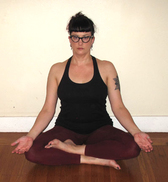 Vowel Spiral A-E-I-O-U-M Begin in a comfortable seated position (you may sit in a chair if needed).Take a few breaths into the lower belly and exhale naturally through the nose. When you are ready to begin, chant the sounds at a natural speaking pitch. You may also place your hand over the areas of the body where the vibration is strongest.
MUDRAS Mudras are hand gestures that redirect energy and awareness into the body to create specific physical or emotional shifts. Like you would tune a radio to a certain frequency to listen to a particular type of music, you create patterns with the fingers to elicit a particular response in the body. You can practice mudras any time you need to feel a sense of connection to your center. 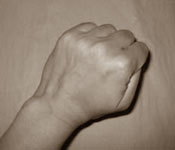 Adhi Mudra Begin in a comfortable seated position (you may also sit in a chair if needed). Make a soft fist with the thumb tucked inside. Turn palms down and rest the hands on the knees. Intended Benefits: Creates a sense of grounding and reduces anxiety 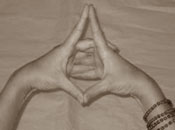 Uttarabodhi Mudra Clasp hands together and press index fingers together and thumbs together and open the center of the palms. Variation I: Hold hands in front of belly with the sides of the thumbs, heels of the hands and sides of the pinkie fingers against abdomen. Creates a sense of self-nurturance. Variation II: Hold hands in front of heart with the sides of the index fingers and sides of the thumbs against the sternum. Activates the thymus gland to increase immunity. RECLINING YOGA This gentle reclining yoga series can be used as a warm-up for the other yoga postures in this sequence or as a stand-alone practice when you are feeling fatigued. As you move through the postures, follow the pace of your breath; be sure to only move in a comfortable range of motion and for a comfortable length of time. If you become light-headed or nauseated while you are practicing, stop and rest with the knees bent and the feet on the floor or roll to the side for a few moments before continuing. 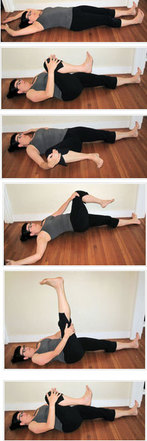 Floor Vinyasa
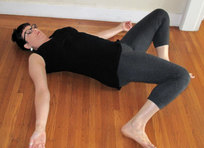 Windshield Wipers Bend the knees and place the feet on the floor as wide as your mat. On an inhalation lower knees to the left about half way to the floor. Exhale and engage belly as you bring knees back to the center. Inhale as you repeat to the right side, and exhale back to the center. Repeat alternately with the breath 5 times per side. Intended Benefits: Broadens back of pelvis, stretches outside of legs, gently compresses the abdominal organs FINAL RELAXATION It is important to give yourself a few minutes at the end of your practice to rest in stillness and silence so that the gifts of the practice can be fully integrated into your body and mind. You may stay in the Body Scan posture and rest for as long as you like but be sure to rest for at least 5 minutes. Feel free to set a timer if you are concerned that you might fall asleep. 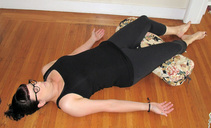 Relaxation Pose Lay on the back with legs straight and feet relaxed to sides. Move arms away from sides slightly and turn palms to face the ceiling. You may use support under the knees for low back pain; and a folded blanket under the head if needed. Rest at least 5 minutes. Intended Benefits: Allows for integration of mind and body after asana practice, promotes restful awareness
0 Comments
Leave a Reply. |
Index:Archives:
September 2022
I attend Cheryl's class regularly and feel that my practice has improved immensely over the past few years due to her expert coaching. Her teaching style is clear and compassionate and her previous experience in teaching adults is evident in her organized approach and easy to understand instructions. I also appreciate that Cheryl not only teaches us about how to correctly position ourselves, but also touches on many aspects of yoga philosophy, which in turn has deepened my personal practice and heightened my awareness of the connection between mind and body, breath and relaxation. |

 RSS Feed
RSS Feed
